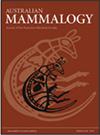更正:昆士兰热带潮湿地区的白足邓纳特(Sminthopsis leucopus),并描述了一个新亚种
IF 1.2
4区 生物学
Q3 ZOOLOGY
引用次数: 0
摘要
白足雀(Sminthopsis leucopus)的种群分布在澳大利亚昆士兰州北部的热带湿热带生物区,与温带的新南威尔士州、维多利亚州和塔斯马尼亚州的同类生物区相隔约1800公里。在昆士兰州东北部进行了针对性调查,获得了18年来首次在昆士兰州捕获的新记录。我们评估了北昆士兰种群与新南威尔士州、维多利亚州和塔斯马尼亚州的S. leucopus的遗传和形态差异,并结合分布和栖息地的差异来评估该分离物是否应该被描述为一个独特的分类单元。线粒体细胞色素b基因测序显示,北昆士兰种群与S. l. ferruginifrons(维多利亚)和S. l. leucopus(塔斯马尼亚)之间的遗传差异分别为2.3-2.8%和4.3-4.8%。基于遗传差异、颅骨形态、栖息地差异和地理隔离,我们将北昆士兰种群描述为一个新的浅槠亚种。考虑到其分布面积小、密度低、地处热带高地以及受气候变化的潜在威胁,建议将其列为濒危物种。本文章由计算机程序翻译,如有差异,请以英文原文为准。
Corrigendum to: White-footed dunnarts (Sminthopsis leucopus) in Queensland’s Wet Tropics, with the description of a new subspecies
A population of white-footed dunnarts (Sminthopsis leucopus) occurs in the Wet Tropics bioregion of tropical north Queensland, Australia separated by about 1800 km from conspecifics in temperate New South Wales, Victoria and Tasmania. We conducted targeted surveys for S. leucopus in north-east Queensland and obtained new records, including the first reported capture of the species in Queensland in 18 years. We assessed the genetic and morphological divergence of the north Queensland population against New South Wales, Victorian and Tasmanian S. leucopus, in conjunction with distribution and habitat differences, to assess whether this isolate should be described as a distinct taxon. Sequencing of the mitochondrial Cytochrome b gene revealed genetic divergence estimates of 2.3–2.8% and 4.3–4.8% between the north Queensland population and S. l. ferruginifrons (Victoria) and S. l. leucopus (Tasmania) respectively. Based on genetic divergence, cranial morphology, differences in habitat, and geographical isolation, we describe the north Queensland population as a new subspecies of Sminthopsis leucopus. We suggest a conservation classification of Endangered given its small distribution, apparent low density, tropical upland location and potential threats, especially related to climate change.
求助全文
通过发布文献求助,成功后即可免费获取论文全文。
去求助
来源期刊

Australian Mammalogy
ZOOLOGY-
CiteScore
2.50
自引率
8.30%
发文量
26
期刊介绍:
Australian Mammalogy is a major journal for the publication of research in all branches of mammalogy. The journal’s emphasis is on studies relating to Australasian mammals, both native and introduced, and includes marine mammals in the Antarctic region. Subject areas include, but are not limited to: anatomy, behaviour, developmental biology, ecology, evolution, genetics, molecular biology, parasites and diseases of mammals, physiology, reproductive biology, systematics and taxonomy.
Australian Mammalogy is for professional mammalogists, research scientists, resource managers, consulting ecologists, students and amateurs interested in any aspects of the biology and management of mammals.
Australian Mammalogy began publication in 1972 and is published on behalf of the Australian Mammal Society.
 求助内容:
求助内容: 应助结果提醒方式:
应助结果提醒方式:


